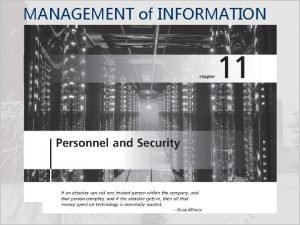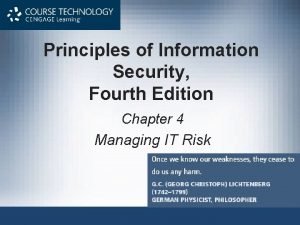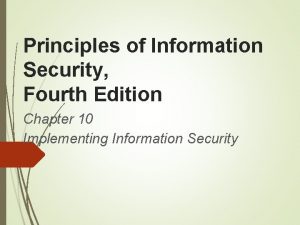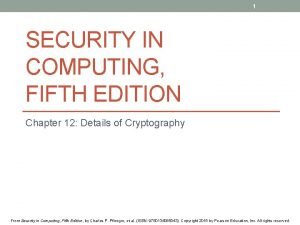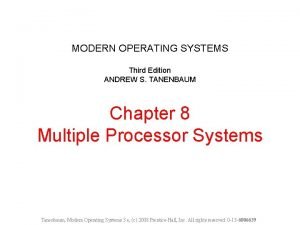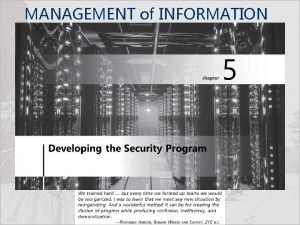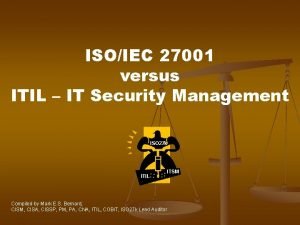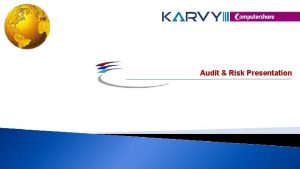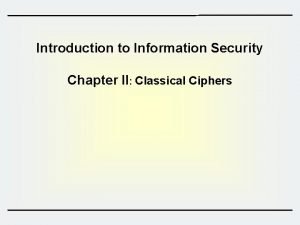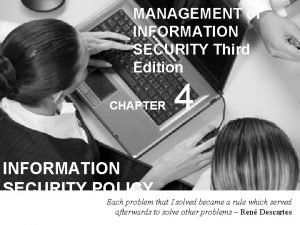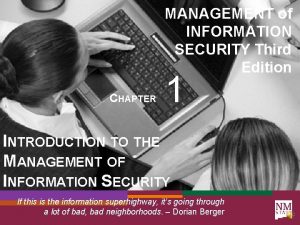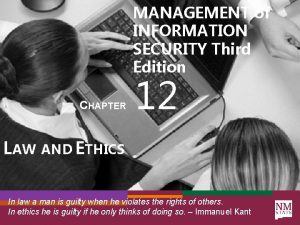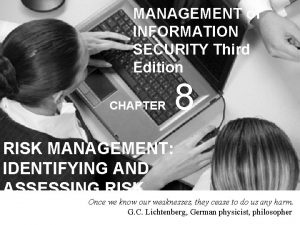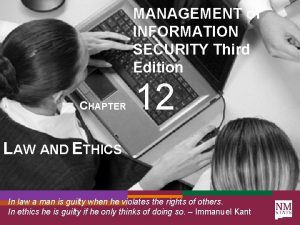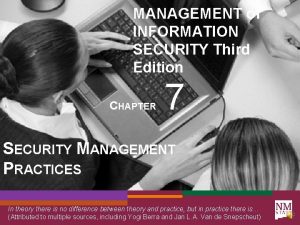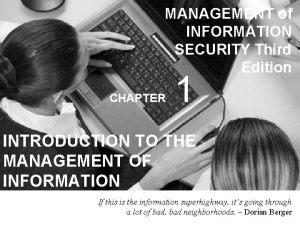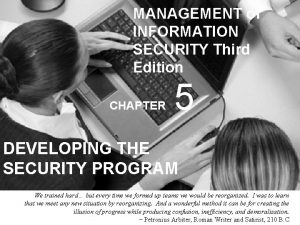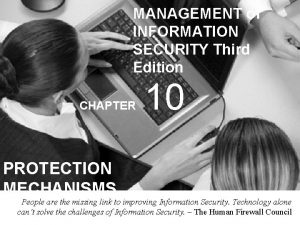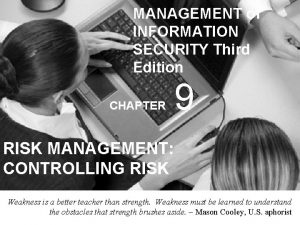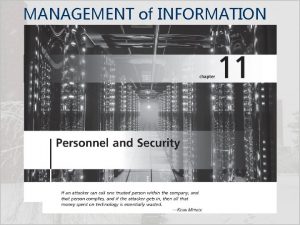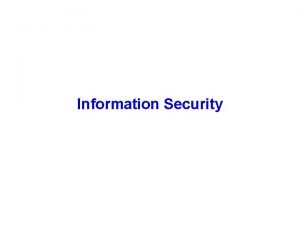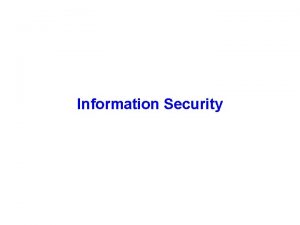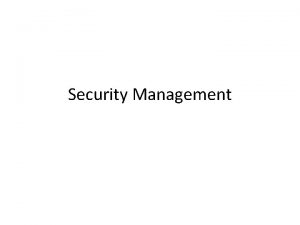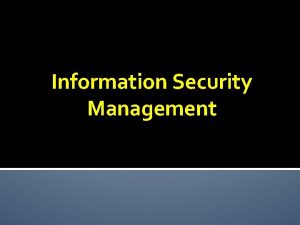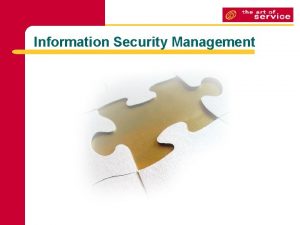MANAGEMENT of INFORMATION SECURITY Third Edition CHAPTER 7







































- Slides: 39

MANAGEMENT of INFORMATION SECURITY Third Edition CHAPTER 7 SECURITY MANAGEMENT PRACTICES In theory there is no difference between theory and practice, but in practice there is… (Attributed to multiple sources, including Yogi Berra and Jan L. A. Van de Snepscheut)

Objectives • Upon completion of this chapter you should be able to: – List the elements of key information security management practices – Describe the key components of a security metrics program – Identify suitable strategies for the implementation of a security metric program – Discuss emerging trends in the certification and accreditation of U. S. federal IT systems

Introduction • Value Proposition – Organizations strive to deliver the most value with a given level of investment – Developing and using sound and repeatable information security management practices makes accomplishing this more likely

Benchmarking • To generate a security blueprint – Organizations usually draw from established security models and practices – Another way is to look at the paths taken by organizations similar to the one for which you are developing the plan • Benchmarking – Following the existing practices of a similar organization, or industry-developed standards – Can help to determine which controls should be considered – Cannot determine how those controls should be implemented in your organization

Recommended Security Practices • Best Practices – Security efforts that seek to provide a superior level of performance in the protection of information – Considered among the best in the industry – Balance the need for information access with the need for adequate protection – Demonstrate fiscal responsibility – Companies with best practices may not be the best in every area

The Gold Standard • Some organizations prefer to implement the most protective, supportive, and yet fiscally responsible standards they can • Gold standard – A model level of performance that demonstrates industrial leadership, quality, and concern for the protection of information – Implementation requires a great deal of financial and personnel support

Selecting Recommended Practices • Choosing which recommended practices to implement can pose a challenge for some organizations – In industries that are regulated by governmental agencies, government guidelines are often requirements – For other organizations, government guidelines are excellent sources of information and can inform their selection of best practices

Selecting Recommended Practices • Considerations for selecting best practices – Does your organization resemble the identified target organization of the best practice? – Are you in a similar industry as the target? – Do you face similar challenges as the target? – Is your organizational structure similar to the target? – Are the resources you can expend similar to those called for by the best practice? – Are you in a similar threat environment as the one assumed by the best practice?

Limitations to Benchmarking and Recommended Practices • The biggest barrier to benchmarking – Organizations don’t talk to each other • A successful attack is viewed as an organizational failure, and is kept secret, insofar as possible • More and more security administrators are joining professional associations and societies like ISSA and sharing their stories and lessons learned – An alternative to this direct dialogue is the publication of lessons learned

Baselining • A value or profile of a performance metric against which changes in the performance metric can be usefully compared • Process of measuring against established standards • Baseline measurements of security activities and events are used to evaluate the organization’s future security performance

Self-Assessment • People: – Do you perform background checks on all employees with access to sensitive data, areas, or access points? – Would the average employee recognize a security issue? – Would they choose to report it? – Would they know how to report it to the right people?

Self-Assessment • Processes – Are enterprise security policies updated on at least an annual basis, employees educated on changes, and consistently enforced? – Does your enterprise follow a patch/update management and evaluation process to prioritize and mediate new security vulnerabilities? – Are the user accounts of former employees immediately removed on termination? – Are security group representatives involved in all stages of the project life cycle for new projects?

Self-Assessment • Technology – Is every possible route to the Internet protected by a properly configured firewall? – Is sensitive data on laptops and remote systems encrypted? – Do you regularly scan your systems and networks, using a vulnerability analysis tool, for security exposures? – Are malicious software scanning tools deployed on all workstations and servers?

Performance Measures • Costs, benefits and performance of Info. Sec – Are measurable, despite the claim of some CISOs that they are not • Measurement requires the design and ongoing use of an Info. Sec performance management program based on effective performance metrics

Info. Sec Performance Management • The process of designing, implementing and managing the use of collected data elements called measures – To determine the effectiveness of the overall security program • Measures are data points or computed trends that indicate the effectiveness of security countermeasures or controls

Info. Sec Performance Management • Organizations use three types of measures – Those that determine the effectiveness of the execution of information security policy (ISSPs) – Those that determine the effectiveness and/or efficiency of the delivery of information security services – Those that assess the impact of an incident or other security event on the organization or its mission

Info. Sec Performance Management • Critical factors for the success of an information security performance program – – Strong upper level management support Practical information security policies and procedures Quantifiable performance measures Results oriented measures analysis

Info. Sec Metrics • Info. Sec metrics – Applying statistical and quantitative approaches of mathematical analysis to the process of measuring the activities and outcomes of the Info. Sec program • Metrics means detailed measurements • Measures refers to aggregate, higher-level results – The two terms are used interchangeably in some organizations

Info. Sec Metrics • Questions to answer before collecting, designing, and using measures – – – Why should these statistics be collected? What specific statistics will be collected? How will these statistics be collected? When will these statistics be collected? Who will collect these statistics? Where (at what point in the function’s process) will these statistics be collected?

Building the ISM Program • An information security measures program – Must be able to demonstrate value to the organization • Necessary even with strong management support • Capability Maturity Model Integrated (CMMI) – One of the most popular references that support the development of process improvement and performance measures – Developed by The Software Engineering Institute at Carnegie Mellon

Building the ISM Program • Another popular approach – NIST SP 800 - 55 R 1: Performance Measurement for Information Security – Major activities • The identification and definition of the current information security program • Development and selection of specific measures to gauge the implementation, effectiveness, efficiency, and impact of the security controls

Source: Course Technology/Cengage Learning (Based on NIST SP 800 -55 Rev. 1)

Specifying Info. Sec Measures • Assess and quantify what will be measured – One of the critical tasks • While Info. Sec planning and organizing activities may only require time estimates – You must obtain more detailed measurements when assessing the effort spent to complete production tasks and the time spent completing project tasks

Collecting Info. Sec Measures • Some thought must go into the processes used for data collection and record keeping • Once the question of what to measure is answered – The how, when, where, and who questions of metrics collection must be addressed • Designing the collection process requires consideration of the metric’s intent – Along with a thorough knowledge of how production services are delivered

Collecting Info. Sec Measures • Determine whether the measures used will be macrofocus or micro-focus – Macro-focus measures examine the performance of the overall security program – Micro-focus measures examine the performance of an individual controller or group of controls within the information security program • Or use both macro- and micro-focus measures in a limited assessment

Collecting Info. Sec Measures • Organizations manage what they measure – It is important to prioritize individual metrics in the same manner as the performance they measure • Use a simple low-, medium-, or high-priority ranking system – Or a weighted scale approach • Involves assigning values to each measure based on its importance in the overall information security program, and on the overall risk mitigation goals and the criticality of the systems

Collecting Info. Sec Measures • Performance targets – Make it possible to define success in the security program – Many measures have a 100% target goal • Other types of performance measures – Those that determine relative effectiveness, efficiency, or impact of information security on the organization’s goals • Are more subjective and require solid native and subjective reasoning

Collecting Info. Sec Measures Source: NIST SP 800 -55, Rev 1

Collecting Info. Sec Measures Table 7 -2 b Example performance measures documentation Source: NIST SP 800 -55, Rev 1

Candidate Measures • Percentage of the organization's information systems budget devoted to information security • Percentage of high vulnerabilities mitigated within organizationally defined time periods after discovery • Percentage space of remote access points used to gain unauthorized access • Percentage of information systems personnel that have received security training • Average frequency of audit records review and analysis for inappropriate activity

Candidate Measures • Percentage of new systems that have completed certification and accreditation (C&A) prior to their implementation • Percentage approved and implemented configuration changes identified in the latest automated baseline configuration • Percentage of information systems that have conducted annual contingency plan testing

Candidate Measures • Percentage of users with access to shared accounts • Percentage of incidents reported within required time frame per applicable incident category • Percentage of system components that undergo maintenance in accordance with formal maintenance schedules • Percentage of media that passes sanitization procedures testing • Percentage of physical security incidents allowing unauthorized entry into facilities containing information assets

Candidate Measures • Percentage of employees who are authorized access to information systems only after they sign an acknowledgment that they have read and understood the appropriate policies • Percentage of individuals screened before being granted access to organizational information and information systems • Percentage of vulnerabilities remediated within organization-specified time frames • Percentage of system and service acquisition contracts that include security requirements and/or specifications

Info. Sec Performance Measurement Implementation • Information security performance measures must be implemented and integrated into ongoing information security management operations • It is insufficient to simply collect these measures once – Performance measurement is an ongoing, continuous improvement operation

Collecting Info. Sec Measures Figure 7 -2 Information security measurement program implementation process Source: Course Technology/Cengage Learning

Reporting Info. Sec Performance Measures • Listing the measurements collected does not adequately convey their meaning • Decisions must be made about how to present correlated metrics • Consider to whom the results of the performance measures program should be disseminated, and how they should be delivered

Emerging Trends In Certification And Accreditation • Accreditation – The authorization of an IT system to process, store, or transmit information. – It is issued by a management official and serves as a means of assuring that systems are of adequate quality – Challenges managers and technical staff to find the best methods to assure security, given technical constraints, operational constraints, and mission requirements

Emerging Trends In Certification And Accreditation • Certification – The comprehensive evaluation of the technical and nontechnical security controls of an IT system • Supports the accreditation process that establishes the extent to which a particular design and implementation meets a set of specified security requirements – Organizations pursue accreditation or certification to gain a competitive advantage • Also provides assurance to customers

Summary • Introduction • Security management practices • Emerging trends in certification and accreditation
 Management of information security 5th edition
Management of information security 5th edition Principles of information security 5th edition pdf
Principles of information security 5th edition pdf Principles of management information system
Principles of management information system Ranked vulnerability risk worksheet
Ranked vulnerability risk worksheet 12 principles of information security
12 principles of information security Bulls eye model in information security
Bulls eye model in information security Privatesecurity
Privatesecurity Chapter 9 information management and security
Chapter 9 information management and security Visa international security model
Visa international security model Cnss security model 27 cells example
Cnss security model 27 cells example Class 6 cavity
Class 6 cavity Senile carious lesions
Senile carious lesions Security in computing 5th edition ppt chapter 2
Security in computing 5th edition ppt chapter 2 Principle of economics third edition
Principle of economics third edition Acid chloride + grignard reagent
Acid chloride + grignard reagent Organic chemistry third edition david klein
Organic chemistry third edition david klein Business mathematics third edition
Business mathematics third edition Modern operating systems tanenbaum
Modern operating systems tanenbaum Fundamentals of corporate finance canadian edition
Fundamentals of corporate finance canadian edition Fundamentals of corporate finance 3rd canadian edition
Fundamentals of corporate finance 3rd canadian edition Lifespan development third edition
Lifespan development third edition Lifespan development third edition
Lifespan development third edition Essential cell biology third edition
Essential cell biology third edition Joey's first 14 quiz grades in a marking period were
Joey's first 14 quiz grades in a marking period were Information technology project management 9th edition
Information technology project management 9th edition Blue project chapter 5
Blue project chapter 5 Vertical
Vertical Information technology project management 8th edition
Information technology project management 8th edition Information technology project management 9th edition
Information technology project management 9th edition Introduction to management information systems 5th edition
Introduction to management information systems 5th edition Voyage estimating decision support system
Voyage estimating decision support system Information technology project management 9th edition
Information technology project management 9th edition Using mis (10th edition) 10th edition
Using mis (10th edition) 10th edition Zulily case study
Zulily case study Project management for information security
Project management for information security Itil vs iso 27001
Itil vs iso 27001 Audit notification
Audit notification Contemporary approach
Contemporary approach Scytale
Scytale Network security essentials 5th edition
Network security essentials 5th edition
